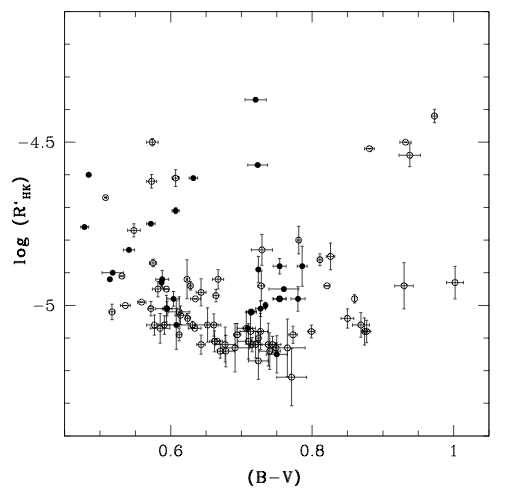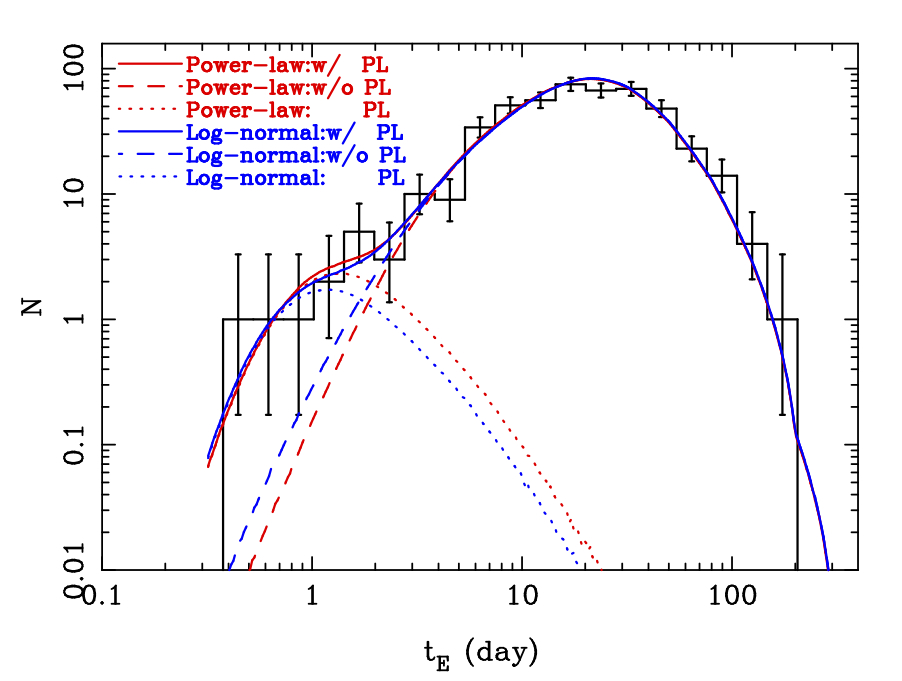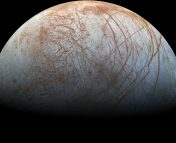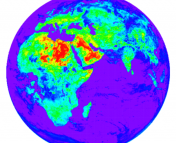Title: The HD 137496 system: A dense, hot super-Mercury and a cold Jupiter
Authors: T. A. Silva, O.D.S Demangeon, S. C. C. Barros, D. J. Armstrong, J. F. Otegi, D. Bossini, E. Delgado Mena, S. G. Sousa, V. Adibekyan, L. D. Nielsen, C. Dorn, J. Lillo-Box, N. C. Santos, S. Hoyer, K. G. Stassun, J. M. Almenara, D. Bayliss, D. Barrado, I. Boisse, D. J. A. Brown, R. F. Díaz, X. Dumusque, P. Figueira, A. Hadjigeorghiou, S. Hojjatpanah, O. Mousis, A. Osborn, A. Santerne, P. A. Strøm, S. Udry, and P. J. Wheatley
First author university: Universidade do Porto, Portugal
Status: Submitted to Astronomy & Astrophysics, open access through arXiv
Since its launch in 2009, NASA’s Kepler mission has been one of the cornerstones of exoplanet research. It has discovered over 2500 now confirmed planets of all shapes, sizes, and orbits, and conclusively demonstrated that many planetary systems in our galaxy look absolutely nothing like our own.
One of the main goals in current exoplanet studies is figuring out a way to relate observable stellar properties, like star type and composition, to the planet types that occur in other planetary systems, in the hope of better understanding the likely chemical compositions of those planets. However, alongside the more common super-Earths and sub-Neptunes, there are some planets with properties that are more difficult to relate to their stars, potentially hinting at processes other than just planet formation that are important during planet formation and evolution.
Today’s paper presents the observation of just such an unusual planet. It is an incredibly dense, hot and Earth-sized planet known as a “super-Mercury”. Orbiting the 8.3 billion-year-old G star HD 137496, it is one of only five planets of this type ever discovered!
A high-density detection
The super-Mercury and a cold, Jupiter-like planet on an eccentric orbit further from the star were detected using transit photometry. Utilizing this method, the authors looked for dips in the brightness of HD 137496 caused by the two planets passing between the host star and the Kepler spacecraft. The more the star’s brightness decreases during the dip, the larger the planetary radius. The longer the dip lasts for, the longer the orbital period of each planet (i.e. the slower it is moving along its orbit, although long dips can also indicate planets with highly eccentric orbits!). They then used radial velocity measurements to calculate the masses of the two planets. This method relies on the fact that planets exert gravitational effects on their host stars, causing them to wobble slightly, which is detectable through changes in the stellar spectrum caused by tiny red and blue shifts as the star moves back and forth.
The authors found that the super-Mercury planet has an Earth-like radius, but is roughly four times Earth’s mass (Figure 1), making it incredibly dense. By assuming that the planet has a similar structure to the Earth – a dense iron core surrounded by a layer of rock – the paper finds that the best match for HD 137496 b is a planet made up of 72±11% iron. This makes it very similar to Mercury in our Solar System, which is also around 70% iron, but HD 137496 b is seventy times more massive!
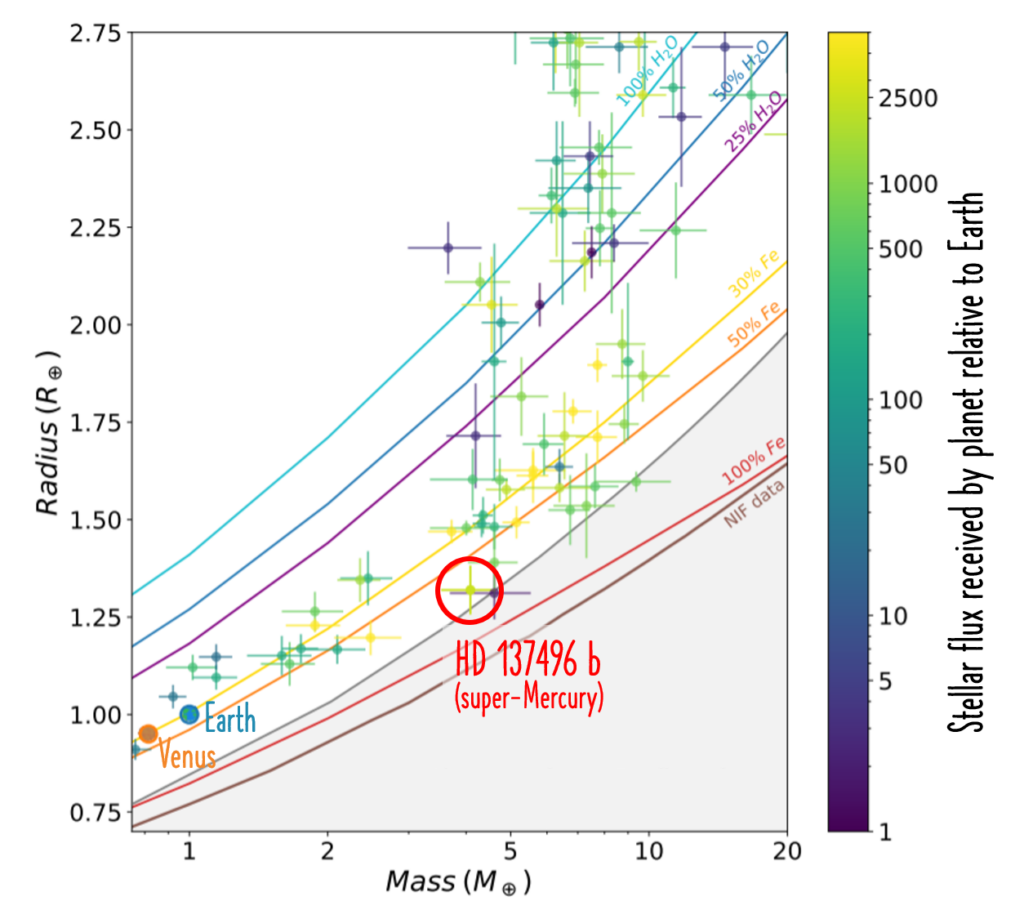
A compositional conundrum
Despite the super-Mercury’s high iron content, the spectrum of the star HD 137496 actually has very little iron in it – the ratio of rock forming elements to metal core forming elements in the star is too high to form a planet with such a high density just from dust and gas with the same chemical composition as the host star. HD 137496 b has an iron/rock ratio of 2:3, whereas its star has an iron/rock ratio between 1:500 and 1:50! This means, for HD 137496 b to be so dense, there must have been some kind of process that made the planet more iron-rich.
One of the main mechanisms proposed for forming unusually metal-rich planets – including Mercury – is giant impacts between planets and asteroids, planetesimals, and even other fully-grown planets. Depending on the relative masses of the two objects, the collision speed and the collision angle, simulations of giant impacts show that they can strip away the rocky exteriors of planets but leave behind most or all of the metal core. However, this typically only results in a factor of two increase in the iron fraction of a planet, which isn’t enough to explain HD 137496 b.
Luckily, there are other potential ways for Mercuries and super-Mercuries to become more iron-rich. Firstly, the protoplanetary disks of dust and gas within which planets form around young stars can change in composition as a function of distance from the star. So, it is possible that a combination of high temperatures and magnetic interactions between the host star and the protoplanetary disk concentrated iron-rich materials where HD 137496 b originally formed. This could mean star compositions might not be very useful to help understand what short period rocky planets are made of. Secondly, planets close to their stars like HD 137496 b are so hot that their rocky surfaces can sometimes just evaporate away!
An unusual opportunity
Growing the catalogue of Mercuries and super-Mercuries across different host stars and planetary systems is the best way to figure out which of these processes is dominant in controlling how iron-rich planets form and evolve throughout the universe. For example, giant impact removal of rock only works for planets <5 Earth masses, so if astronomers find lots of very large iron-rich planets, they could potentially rule out this mechanism.
However, super-Mercury-like exoplanets also offer another exciting observation opportunity. Super-Mercuries can be hot enough to have thin atmospheres made of vaporized rock, or even comet-like tails of rock vapor like Mercury’s exosphere. These rock vapor atmospheres could potentially be observed using spectroscopy, and provide direct observations of the chemical compositions of planets. Super-Mercuries are unique in this way because it is not (yet!) possible to get direct measurements of the chemical composition of the surface of any other type of rocky planet!
Edited by Jana Steuer

